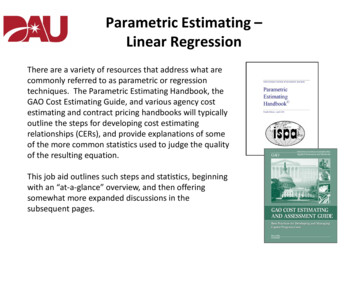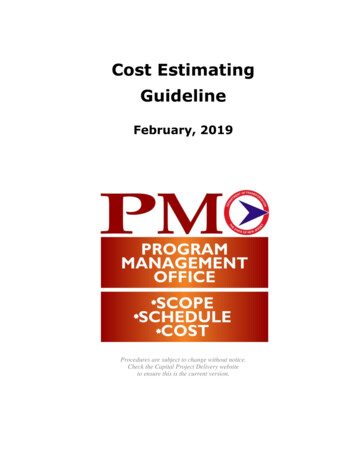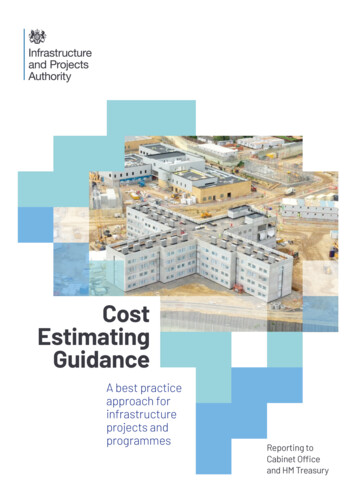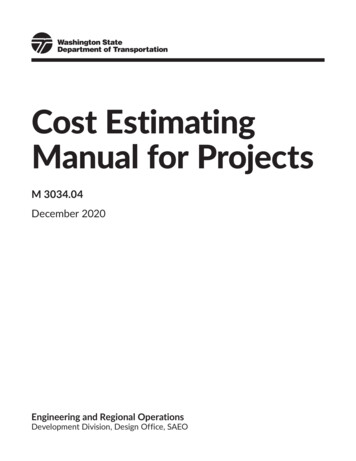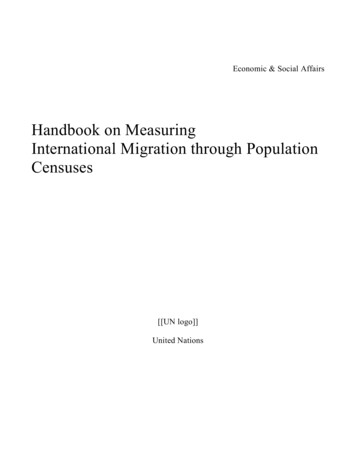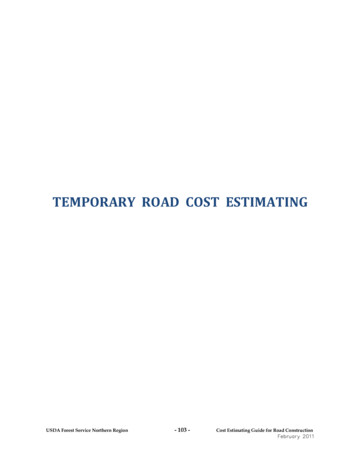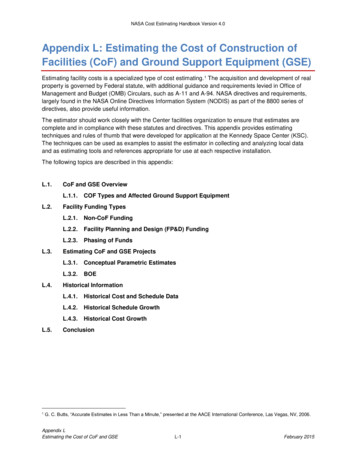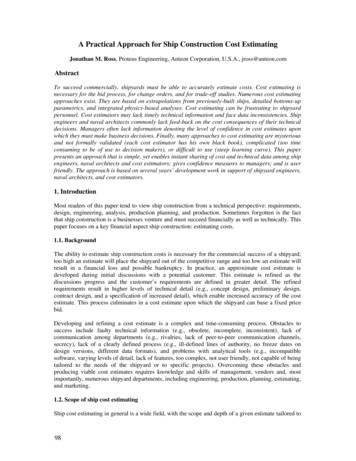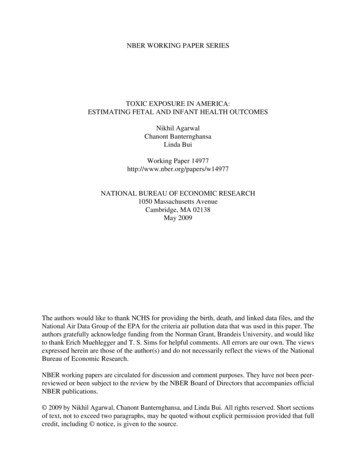
Transcription
NBER WORKING PAPER SERIESTOXIC EXPOSURE IN AMERICA:ESTIMATING FETAL AND INFANT HEALTH OUTCOMESNikhil AgarwalChanont BanternghansaLinda BuiWorking Paper 14977http://www.nber.org/papers/w14977NATIONAL BUREAU OF ECONOMIC RESEARCH1050 Massachusetts AvenueCambridge, MA 02138May 2009The authors would like to thank NCHS for providing the birth, death, and linked data files, and theNational Air Data Group of the EPA for the criteria air pollution data that was used in this paper. Theauthors gratefully acknowledge funding from the Norman Grant, Brandeis University, and would liketo thank Erich Muehlegger and T. S. Sims for helpful comments. All errors are our own. The viewsexpressed herein are those of the author(s) and do not necessarily reflect the views of the NationalBureau of Economic Research.NBER working papers are circulated for discussion and comment purposes. They have not been peerreviewed or been subject to the review by the NBER Board of Directors that accompanies officialNBER publications. 2009 by Nikhil Agarwal, Chanont Banternghansa, and Linda Bui. All rights reserved. Short sectionsof text, not to exceed two paragraphs, may be quoted without explicit permission provided that fullcredit, including notice, is given to the source.
Toxic Exposure in America: Estimating Fetal and Infant Health OutcomesNikhil Agarwal, Chanont Banternghansa, and Linda BuiNBER Working Paper No. 14977May 2009JEL No. I12,Q51ABSTRACTWe examine the effect of exposure to toxic releases that are tracked by the Toxic Release Inventory(TRI) on county-level infant and fetal mortality rates in the United States between 1989-2002. Wefind significant adverse effects of TRI concentrations on infant mortality rates, but not on fetal mortalityrates. In particular, we estimate that the average county-level decrease in aggregate TRI concentrationssaved in excess of 25,000 infant lives from 1989-2002. Using a value of life of 1.8M - 8.7M, thesavings in lives would be valued at 45B - 217.5B. We also find that the effect of toxic exposureon health outcomes varies across pollution media: air pollution has a larger impact on health outcomesthan either water or land. And, within air pollution, releases of carcinogens are particularly problematicfor infant health outcomes. We do not, however, find any significant effect on health outcomes fromexposure to two criteria air pollutants – PM10 and ozone.Nikhil AgarwalDept of EconomicsHarvard UniversityLittauer Center1805 Cambridge StreetCambridge, MA 02138agarwal3@fas.harvard.eduChanont BanternghansaFederal Reserve Bank, St. Loius411 Locust StreetSt. Louis, MO 63102c.banternghansa@gmail.comLinda BuiDept. of EconomicsBrandeis UniversityMail Stop 021P.O. Box 9110Waltham, MA 02454ltbui@brandeis.edu
TOXIC EXPOSURE IN AMERICA :ESTIMATING FETAL AND INFANT HEALTH OUTCOMESFROM 14 YEARS OF TRI REPORTINGI.INTRODUCTIONOver 75,000 different chemical substances, used or manufactured in the United States, arecurrently registered with the EPA under the Toxic Substances Control Act (TSCA). The majorityof those substances are relatively new, having been developed since World War II, and for many,little is known about their effects on health. Since 1988, the Toxic Release Inventory (TRI) hastracked environmental releases by manufacturing plants in the U.S. of 300 to 600 of thesesubstances, all of which are either known to be, or suspected of being, hazardous to human health.It is estimated that, in 2000, more than 100 million pounds of carcinogens, 188 million pounds ofdevelopmental or reproductive toxins, 1 billion pounds of suspected neurological toxins, and 1.7billion pounds of suspected respiratory toxins were released into the nation’s air, water, and land bythe manufacturing sector alone.1Toxic substances face cradle-to-grave regulation in the U.S.: Their storage, handling,transportation, and disposal are all strictly regulated. Yet, for most of these substances, there is noformal regulation of their releases into the environment. In part, this may be due to a belief that atlow levels of perceived exposure there are no significant health effects.2 And, to a large extent, therewas little public concern over toxic releases until the discovery in 1978 of toxic wastes buried1See U.S. PIRG Report, executive summary (January 22, 2003).2No comprehensive data set exists for ambient toxic pollutants. Data on ambient toxic concentrationsfor only a small number of toxic pollutants have been recorded for a select number of states in 1996, and onlyperiodically since that time.-1-
beneath a neighborhood in Love Canal, N.Y., and then of a strong correlation between residentialproximity to Love Canal and significantly elevated rates of cancer, neurological disorders, birthdefects, and still births.Love Canal spurred a number of epidemiological studies into the health effects of toxicexposure. The bulk of that research consists of cross-sectional studies, usually on adults, andprovides mixed results on the relationship between toxic pollution exposure and health outcomes.That is similar to what has been observed in the literature on (non-toxic) air pollution and health.As pointed out by Greenstone and Chay (2003a), the lack of a consensus on the effects of airpollution on health may be explained by identification problems due to omitted variable bias thatoften arise in cross-sectional studies. A second problem is that studies of adult health outcomes maybe flawed by the inability to measure accurately life-time exposure to pollutants. Even abstractingfrom mobility issues, using current levels of pollution to proxy for life-time exposure will beinaccurate if pollution concentration levels have changed dramatically over time, as is true of toxicpollutants (Needham et al. (2005)).A third problem is the absence of data on toxic pollution concentrations. At best, toxicreleases are available at the facility level in the manufacturing sector for facilities that are requiredto report to the TRI. No data exists, however, for TRI non-reporters within the manufacturing sectoror toxic polluters not required to report to the TRI (including mobile sources). Because thecontributions of pollution from these sources are unobserved and change over time, they cannot beaccounted for in cross-sectional studies. Studies thus far, have not controlled for these time-varyingomitted variables, potentially leading to estimation bias.In this study, we investigate the health effects of toxic pollution exposure on two particularly-2-
vulnerable groups: fetuses surviving at least 20 weeks in utero and infants under one year of age.By doing so, we mostly avoid the problems associated with trying to proxy for life-time exposurelevels. Empirical studies show that mobility rates for pregnant women are low, so that fetal exposurecan reasonably be approximated by pollution concentrations in the mother’s county of residence.We construct a panel in which we make use of facility level annual toxic release data that weaggregate to the county-year level and link to files of all births and deaths in the U.S. between 1989and 2002. We include a large set of covariates to control for potentially confounding effects andexplicitly include proxy variables to control for toxic pollution from both mobile sources and fromfacilities in the manufacturing sector that do not report to the TRI – two potentially importantvariables which have systematically been omitted from other studies. Our central identificationstrategy is based on using exogenous changes in toxic pollution concentrations within state-years toestimate the causal effect of toxic pollution exposure on infant and fetal health outcomes.Our findings show that there are significant health consequences to infants from exposureto toxic releases. We do not, however, find similar outcomes for fetal health, although this may bedue to “harvesting” that occurs during the first 20 weeks of gestation so that fetuses that wouldnormally survive at least 20 weeks in utero survive less than 20 weeks due to toxic pollutionexposure. We cannot test this hypothesis directly, however, due to poor data quality for fetal deathsthat occur during the first 20 weeks of gestation.We do find that toxic air releases are significantly more harmful to infant health than otherforms of releases (e.g. water or land) and that carcinogenic air releases have the largest effect oninfant mortality. We estimate that the average county-level decline in toxic air concentrations of9.5% per year in the manufacturing sector alone led to a total decline in infant mortality of-3-
approximately 4% in 14 years. The over all reductions by TRI reporters in the manufacturing sectorin various categories of TRI concentrations (by chemical category and by media) during our sampleled to a savings of over 13,800 infant lives. Using a value of a statistical life measure of between 1.8M and 8.7M, we estimate that the value of the saved lives ranges between 25B and 121B.Our findings, however, may significantly under estimate the actual effects of toxic releases on infantmortality, as they do not include the adverse health consequences of releases by TRI non-reporters.We find evidence to suggest that toxic releases by non-reporting facilities may add significantly tothe impact on infant health outcomes. In contrast to other studies, we do not find any measurablehealth effects on infants or fetuses from exposure to ambient concentrations of criteria air pollutants,specifically, particulate matter (PM10), or ozone (O3).The rest of the paper is organized as follows. In Section II we provide a brief summary ofthe literature, focusing in particular on epidemiological studies that relate fetal and infant healthoutcomes to toxic pollution exposure. We discuss data sources that are used in our study in sectionIII; descriptive statistics are given in Section IV. Section V describes our methodology, and SectionVI discusses data issues. In Section VII, we present our results. In Section VIII we describe testsfor robustness, and in Section IX we discuss policy implications and provide concluding remarks.II.BACKGROUNDIt is generally believed that both fetuses and infants are particularly vulnerable to exposureto toxic pollutants, although the biological mechanisms through which that occurs are not yet wellunderstood. The National Research Council described four ways in which these two groups may beespecially vulnerable to environmental toxins (Landrigan et al. (2004)). First, children havedisproportionately heavy exposures to many environmental agents because of their size. Relative-4-
to their body weight, they consume significantly more food and water than adults. Toxins that arepresent in the food system or in the water supply may therefore be more harmful to them than toadults. Second, because the central nervous system is not fully developed until at least 6 months postbirth (Choi (2006)), the blood-brain barrier may be breached by some environmental toxins in amanner that is less likely later in life. Third, developmental processes are more easily disruptedduring periods of rapid growth and development before and after birth, making exposure toenvironmental toxins during these stages particularly harmful. Fourth, because children have longerlife-spans, exposure to environmental toxins at an earlier age, or even in utero, may lead to a higherprobability of developing a chronic disease than if exposure were to occur later in life. Finally, itshould be noted that for infants, both pre- and post-natal exposure to toxic pollution may beimportant determinants of their health outcome.Before addressing the question of fetal or infant health outcomes from exposure toenvironmental toxins, it is important to address directly the question of how to measure toxicexposure. Fetal exposure is a direct consequence of maternal exposure. Most studies assume thatthe relevant level of exposure may be captured by the mother’s place of residence at the time ofdelivery. That will be true, however, only if the mobility rate of pregnant women is low. Publishedstudies have estimated residential mobility during pregnancy to range between 12% and 32%, withone study estimating that, of those that moved, only 5% changed municipality and 4% changedcounty during pregnancy. (See Fel et al. (2004), Khoury et al. (1988), Shaw et al. (1992), and Zenderet al. (2001).) In combination, those studies would suggest that, at most, 1.2% of pregnant womenwould not have been in residence within their child’s birth-designated county during pregnancy andat most 1.6% would not have been in residence within their child’s birth-designated municipality.-5-
Fel et al. (2004) also report that mobility was not correlated with exposure to chemicals or pesticidesin the workplace or at home. They did find, however, that both younger (age 25) and older (age 35) women were more mobile, as were unemployed women and those from lower income groups.The finding of low mobility rates amongst pregnant women also is important as it boundsthe potential confounding effects stemming from pregnant women moving to counties (ormunicipalities) with different pollution characteristics based on a Tiebout-type sorting mechanism(see Banzhaf and Walsh (2008)). This could lead to sample selection bias if, for example, high-riskpregnant women were sorting into high pollution counties based on some set of personalcharacteristics which then might lead to high infant or fetal mortality rates being falsely attributedto high pollution concentrations.Several epidemiological studies look at health outcomes for prenatal exposure to toxicpollutants. A number find a correlation between prenatal exposure and spontaneous abortion,malformation, and low birth weight (Bove et al. (1995), Carpenter (1994), Landrigan et al. (1999)).Others, however, find no such correlation (Baker et al. (1988), Croen et al. (1997), Fielder et al.(2000), Kharrazi (1997), Sonsiak (1994)). More recent work suggests that the health effects may betied only to particular categories of toxic pollutants. For example, Meuller et al. (2007) look at therelationship between fetal deaths and maternal proximity to hazardous waste sites, but findsstatistically significant results only for proximity to waste sites associated with pesticides.Infant health outcomes may be affected both by exposure that occurs in utero and after birth.It is well documented that infants are at particular risk for exposure to heavy metals, such as lead andmethyl mercury (Landrigan et al. (2004 )). Choi et al. (2004) find that there is a higher risk ofchildhood brain cancer when mothers live close to a TRI emitting facility. Making use of TRI data,-6-
Marshall et. al. (1997) find a slight increase in certain birth defects due to exposure to toxic releases.Because of similarities in terms both of econometric issues and issues of causality, it is usefulto look also at the literature on (non-toxic) air pollution and health. Greenstone and Chay (2003a),for example, examine the effects of total suspended particulates (TSPs) on infant mortality rates.They use the changes in TSP pollution concentrations generated by the 1981-82 recession as a“quasi-experiment” to identify changes in infant mortality at the county level in the U.S. Theirunderlying assumption is that the recession-induced variation in county-level TSP concentrationsis exogenous to infant mortality rates. They compare cross-sectional results for each year between1978 and 1984 to a panel-data, fixed-effects model (in first-differences) and show that the traditionalcross-sectional approach can produce misleading results due to unobserved, omitted confounders.Using an approach that mitigates many of these identification problems, Greenstone and Chay findthat a 1 :g/m3 reduction in TSP concentration results in approximately 4to 8 fewer infant deaths per100,000 live births at the county level. Over the 1980-82 recession, they estimate that the reductionin TSPs led to approximately 2,500 fewer infant deaths.Currie and Neidell (2005) also examine the relationship between ambient air pollutionconcentrations and infant and fetal mortality. They focus on California during the 1990s andexamine 3 different criteria air pollutants: carbon monoxide, particulate matter, and ozone. Unlikemost other air pollution studies, Currie and Neidell allow for correlations across pollutants in theireffect on infant mortality. Taking individual data that they aggregate up to the zip code--monthlevel, they estimate an approximate linear hazard model and find a significant effect of carbonmonoxide on infant mortality (although not on fetal mortality) and estimate that the significantreduction in carbon monoxide concentrations in California saved approximately 1,000 infant lives-7-
over the 1990s.Taking a cue from both Greenstone and Chay (2003a, 2003b) and Currie and Neidell (2005),we make use of the reduction in TRI releases across location and time to identify the effects of toxicpollution on health. Our maintained assumption is that both the reductions in toxic releases and thedistribution and characteristics of industries across counties over time are exogenous to determinantsof infant and fetal health outcomes. We base our assumptions on the following evidence: (1) Largepolluting companies of TRI “priority” substances were contacted in early 1991and 1992 and wereinvited to participate in a “voluntary” abatement program called the TRI 33/50. Participants of thisprogram agreed to reduce their releases by 33% from their 1988 baselines by 1992 and 50% by 1995.In total, over 1000 companies (and their facilities) participated in this program and all targetreductions were met. (2) The deadlines to meet the requirements set out under the MontrealProtocol, an international agreement that required the phase-out of several ozone-depleting chemicalsthat are listed substances under the TRI occurred in 1994 and 1996 (and later in 2003, and 2005).These phase-out deadlines were also met. (3) Over 26 states adopted Toxic Use ReductionPrograms to encourage the reduction of toxic substance use in the production process. Theseprograms primarily provided educational outreach to polluters to help them abate, although somestates instituted (numeric) state-wide reduction goals (some with target compliance dates, as wellas penalties associated with non-compliance). (4) Nationwide recessions occurred in 1990-1991 andin 2001. The contraction of manufacturing during this time period also led to a reduction in TRIreleases across the country. For many industries, for example the electronic industry, the recessionin 2001 was exacerbated by a build up in inventory during the 1990 boom years, which furthersuppressed production. And (5) because reductions in toxic releases are “voluntary” in nature, only-8-
facilities and industries that can abate at low cost will do so. We observe large variations acrossindustry in their reported abatement activities. For example, during our sample period, petroleumrefineries reduced their releases by 74% whereas the food industry increased their releases by morethan 174%. We also observe that larger facilities report larger reductions in abatement than smallerfacilities.Taking these five points together, we believe that there is ample evidence that themajority of the toxic reductions may be taken as exogenous to factors that determine infant and fetalhealth outcomes.To control for other potential confounding effects, we include a rich vector of parentalcharacteristics, prenatal care information, and medicaid and other income transfers. We also allowfor the possibility that other types of pollution exposure may affect health outcomes. In particular,we include measures for particulate matter and ozone concentration. Those two criteria air pollutantsare also used as a proxy for toxic air pollution concentrations that are derived from mobile sourcesof pollution, as they are highly correlated with fuel combustion. And, unlike other studies that havemade use of TRI data, we construct two unique proxy variables that allow us to control for the effectsof time-varying toxic releases from non-reporting TRI facilities.III.DATAWe combine data from various sources to construct a comprehensive set of measures at thecounty level for the period 1989 to 2002. (We restrict ourselves to these years because of changesin the data format for our primary variables post 2002 that could lead to inconsistencies in themeasurement of our variables.) Data on pregnancy outcomes are from the National Center forHealth Statistics (NCHS). Data on toxic emissions are from the Toxic Release Inventory,maintained by the U. S. Environmental Protection Agency (EPA). Those two data sets are-9-
supplemented by county-level data on income, job composition, transfer payments from health andunemployment benefit programs, and population, all from the U.S. Bureau of Economic Analysis.Data on land and water area are taken from the U.S. Census 2000 Gazetteer Files. In this section weprovide a detailed description of the primary data used in this study.Infant and Fetal Health Outcomes DataOur dependent variables and many important control variables are taken from infant3 birthand death records and fetal death records provided by NCHS. These records are constructed froma census of death and birth certificates, as required by law in all states. The NCHS, in cooperationwith the states and territories of the U.S., has promulgated a uniform instrument with which tocollect information on each fetal death. (Our estimate of pregnancies comes from adding live birthsand reported fetal deaths in a given year; as such it does not include terminated pregnancies.)Infant Data: Birth certificates contain information about parentage, in addition tolimited details about the medical history of the mother and the specific pregnancy. The variables thatwe use as controls include the reported age, education, marital status, and race of the parents;reported tobacco and alcohol consumption; and the level of pre-natal care as indicated by the numberof prenatal visits to a doctor.We use death certificates to identify the cause of death as coded using the InternationalClassification of Diseases. We remove infant deaths caused by external factors (such as physicalinjury) from our measures, as they are not related to the exposure of toxic releases. We refer to theretained observations as “internal” infant deaths.Fetal Data: Information in the fetal death files includes some of the same information3An infant is defined as being an individual under one year of age.-10-
that is available in birth certificates, such as the reported age, education, marital status, and race ofthe parents; tobacco and alcohol consumption; and the level of prenatal care. The period of gestationis also included. Deaths of fetuses at less than 20 weeks are not well reported in the data set. Birthcertificates and fetal death records also report the county of the mother’s residence coded using theFederal Information Processing Standard (FIPS).Using the individual-level data described above, we compute county-level statistics basedon the county of residence of the mother, for infant death rates due to internal causes and death ratesfor fetuses with a period of gestation of more than 20 weeks. Our control variables are likewiseaggregated to the county level, by computing averages of measures such as maternal and paternalage, maternal years of education, and the number of prenatal visits. We also compute for eachcounty and year the fraction of pregnant mothers in each of the following categories: white, AfricanAmerican, mothers that smoke tobacco, mothers that consume alcohol, and mothers that are married.The health data set, thus aggregated to the county-year level by the residence of the mother, is thenmerged with data on toxic releases.Toxic Release DataData on toxic releases are taken from the Toxic Release Inventory. The TRI was introducedin 1986 under the Emergency Planning, Community Right To Know Act (EPCRA) and requires thatall manufacturing plants with ten or more full-time employees that either use or manufacture morethan a threshold level of a listed substance report their toxic releases to a publicly maintaineddatabase. The first year of reporting was 1987. At that time, there were approximately 300 TRI listedsubstances. In 1995, this list was expanded to include 286 new substances. Today (2008), the TRIcovers 581 individually listed chemicals, 27 chemical categories, and 3 delimited categories-11-
containing another 58 chemicals. Reporting thresholds have remained at 10,000 lbs (annually) formost chemicals, with the exception of 4 persistent, bio-accumulative, toxic chemical (PBT)categories, containing 16 PBT chemicals. (See se of changing thresholds and both the addition and deletion of reporting chemicals over time,we restrict our analysis to the stable base set of 1988 chemicals that are not affected by subsequentchanges in reporting thresholds.4TRI data are reported at the facility level. Separate reports are filed for each TRI substancefor which the facility meets the reporting requirements. Information is provided as to whether thetoxic pollutant is released on-site or transferred off-site. We restrict our reported analysis to on-sitereleases, although all results are robust to the inclusion of off-site releases. Data are broken downby medium (air, water, land, etc.), and information is provided as to whether the substance is aknown carcinogen. Using TRI-provided information on chemical CAS number, we further classifyTRI chemicals as a developmental or reproductive toxin if it is listed as such in the State ofCalifornia Safe Drinking Water and Toxic Enforcement Act. The TRI data set also providesinformation on whether a chemical is simultaneously regulated under the Clean Air Act.With these data we construct, for each county-year observation, the total pounds of TRIreleases net of any Clean Air Act releases by air, water, and “land” (where land is the residualcategory aggregate releases - air releases - water releases); broken down by carcinogenic, and4We calculate the correlations between the balanced panel of 1988 chemicals and the newerchemicals that were added to TRI reporting requirements and find that they are low – below 23%. Thissuggests that bias from not including those chemicals in our analysis should be reasonably small.-12-
developmental and/or reproductive toxic emissions.5 (We exclude CAA chemicals from ourmeasures of TRI concentrations to avoid any possibility of “double counting” because we includemeasures of criteria air pollution concentrations in our models of health outcomes.) Using geographic data from the Census 2000 Gazetteer Files, we construct a crude measure of “concentration”by dividing total pounds of releases by land area.Criteria Air Pollution DataWhen examining the relationship between TRI releases and health, it is important to controlfor the effect that other pollutants may have on health outcomes. We therefore supplement the TRIpollution data with data on concentrations of criteria air pollutants, as provided by EPA’s NationalAir Data Group. Those data were extracted from recordings taken from pollution monitors locatedin various counties across the nation. The data set provides means, variances, medians, and higherpercentiles of concentrations observed by monitoring stations in a given day of a year. Of thesevalues, we make use of the daily average concentration and the 95th percentile concentration. Insome counties, there are multiple monitoring stations. In those cases, we use the simple averageacross all monitoring stations for the daily average concentration and for the 95th percentileconcentration.Most counties, however, do not have any monitoring stations that measure allcategories of criteria air pollution concentrations. We choose to concentrate on particulate matter(PM10) and ozone (O3) because these pollutants had the least number of missing county-levelobservations and because a number of studies have shown a potential link between their ambientconcentration levels and adverse health outcomes for both infants and the unborn. An additionalbenefit of including PM10 and O3 in our study is that they are thought to be highly correlated with5Some chemicals are classified as both carcinogenic and developmental and/or reproductive toxins.-13-
mobile source emissions of pollution and are therefore used as controls for toxic pollutionconcentrations from mobile sources of pollution.Other Data SourcesSeveral county-level controls are also used in our study. Data on per capita income,Medicaid transfers, food stamp participation, and other government supplemental income transfersare taken from the Bureau of Economic Analysis (BEA). The fraction of the labor force employedin the manufacturing sector as well as county-level unemployment rates also come from the BEA.The number of facilities by 2-digit SIC code are taken from the County-level Business Patterns datacollected by the U.S. Census Bureau.IV.BIRTHS, DEATHS, AND TOXIC RELEASES: 1989-2002The TRI-internal infant death and fetal death data set consists of 43,124 county-yearobservations; when linked with County Business Pattern data collected by the U.S. Census Bureau,we have 42,617 county-year observations; and when we further include county-level demographicdata, we have 41,908 county-year observations. The last of these data sets is referred to as the “full”sample, which we describe, below.Between 1989 and 2002, there were over 54.3 million live births in the United States, with410,615 internal infant deaths and 381,988 fetal deaths (post 20 weeks) recorded. More than 34.2billion lbs of toxic pollutants were released into the environment by TRI reporters from themanufacturing secto
411 Locust Street St. Louis, MO 63102 c.banternghansa@gmail.com Linda Bui Dept. of Economics Brandeis University Mail Stop 021 P.O. Box 9110 Waltham, MA 02454 ltbui@brandeis.edu. 1 See U.S. PIRG Report, executive summary (January 22, 2003). 2 No compreh ensive data set exists for ambient toxic p ollutants. Data on am bi ent toxic con centrations

